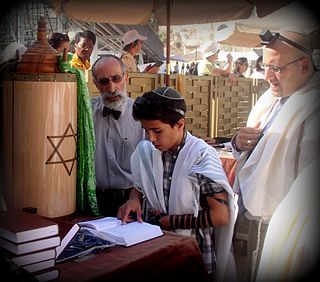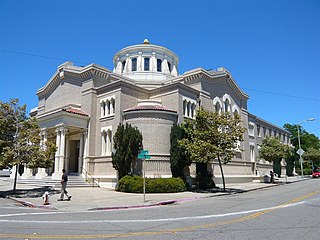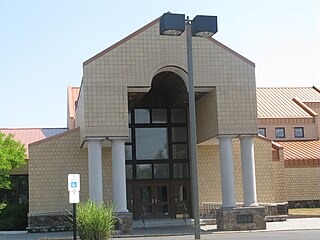
A bar mitzvah (masc.), bat mitzvah (fem.), or b mitzvah, is a coming-of-age ritual in Judaism. According to Jewish law, before children reach a certain age, the parents are responsible for their child's actions. Once Jewish children reach that age, they are said to "become" b'nai mitzvah, at which point they begin to be held accountable for their own actions. Traditionally, the father of a bar or bat mitzvah offers thanks to God that he is no longer punished for his child's sins.

Beth Sholom Congregation is a Conservative Jewish congregation and synagogue located at 8231 Old York Road in Elkins Park, a suburb of Philadelphia, Pennsylvania, in the United States. It is the only synagogue designed by famed architect Frank Lloyd Wright. Completed in 1959, it has been called a "startling, translucent, modernist evocation of an ancient temple, transposed to a Philadelphia suburb by Frank Lloyd Wright". The synagogue building was designated a National Historic Landmark in 2007 for its architecture.

Congregation Beth Elohim, also known as the Garfield Temple and the Eighth Avenue Temple, is a Reform Jewish congregation and historic synagogue located at 274 Garfield Place and Eighth Avenue, in the Park Slope neighborhood of Brooklyn in New York City, New York, United States.

Temple Emanu-El of West Essex is a former Reform Jewish congregation and synagogue that was located at 264 West Northfield Road, in Livingston, in the West Essex section of New Jersey, in the United States. Founded in 1955, the congregation merged with Temple Sinai in Summit in 2018, due to financial reasons.

Bikur cholim refers to the mitzvah to visit and extend aid to the sick. It is considered an aspect of gemilut chasadim. It is traditional to recite prayers for healing, such as the Mi Shebeirach prayer in the synagogue, and Psalms on behalf of the sick. Bikur holim societies exist in Jewish communities around the world. The earliest bikur holim society on record dates back to the early Middle Ages.

Temple Sinai is a Reform Jewish congregation and synagogue located at 2808 Summit Street in Oakland, California, in the United States. Founded in 1875, it is the oldest Jewish congregation in the East San Francisco Bay region.
Beth Israel Congregation is a Reform Jewish congregation and synagogue located at 5315 Old Canton Road in Jackson, Mississippi, in the United States. Organized in 1860 by Jews of German background, it is the only Jewish synagogue in Jackson. Beth Israel built the first synagogue in Mississippi in 1867, and, after it burned down, its 1874 replacement was at one time the oldest religious building in Jackson.

Congregation Beth Israel is a Reform Jewish congregation and synagogue, located at 10460 North 56th Street in Scottsdale, Arizona, in the United States. Incorporated in 1920, the congregation affiliated with the Union for Reform Judaism in 1935.
Beth Israel Congregation is a Conservative synagogue located at 385 Pottstown Pike in Upper Uwchlan Township, Chester County, Pennsylvania, in the United States. The congregation was founded in Coatesville in 1904 as Kesher Israel by Eastern European immigrants, and formally chartered as "Beth Israel" in 1916. It constructed its first building in 1923, and expanded it after World War II.
Congregation Am Tikvah is a combined Conservative and Reform Jewish congregation and synagogue located at 625 Brotherhood Way in San Francisco, California, in the United States. The congregation was formed in 2021 as the result of the merger of the Conservative B'nai Emunah and the Reform Beth Israel Judea congregations, with the latter formed in 1969 through a merger of the Conservative Congregation Beth Israel and the Reform Temple Judea. The congregation is affiliated with both the Union for Reform Judaism and the United Synagogue of Conservative Judaism.

Temple Emanuel Sinai is a Reform Jewish congregation and synagogue located at 661 Salisbury Street, Worcester, Massachusetts, in the United States.

Temple Israel is a Reform Jewish congregation and synagogue located at 2004 East 22nd Place in Tulsa, Oklahoma, in the United States. Founded in 1914, the congregation affiliated with the Union for Reform Judaism in 1915, and constructed its first building on the corner of 14th and Cheyenne Streets in 1919. Early rabbis included Jacob Menkes, Charles Latz, Samuel Kaplan, Jacob Krohngold, and Benjamin Kelsen.
Agudas Achim Congregation is an egalitarian Conservative synagogue located at 2908 Valley Drive, Alexandria, Virginia, in the United States. The synagogue was founded in 1914, and its cemetery was founded in 1933.

Congregation M'kor Shalom was a Reform Jewish synagogue located at 850 Evesham Road, Cherry Hill, Camden County, New Jersey, in the United States.

Beth Tzedec Congregation is a Conservative synagogue on Bathurst Street in Toronto, Ontario, Canada. It was founded in 1955 with the amalgamation of the Goel Tzedec and Beth Hamidrash Hagadol Chevra Tehillim congregations, established respectively in 1883 and 1887. The synagogue has some 2,600 member units, representing over 4,400 members.
Beth El Congregation is a Conservative Jewish congregation and synagogue, located at 8101 Park Heights Avenue, in Pikesville, an outer suburb of greater Baltimore, Maryland, in the United States. The congregation was established in 1948.












